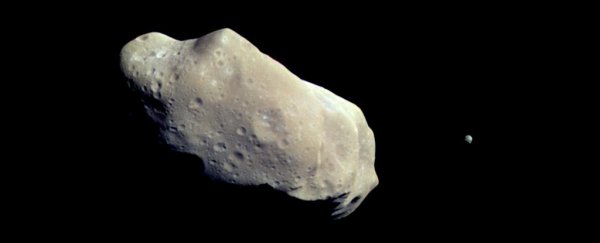An asteroid is a relatively small chunk of rocky minerals that orbits the Sun, often described as a minor planet. When the orbiting object is larger, it's called a planetoid.
They're typically made from much the same materials that make up the inner Solar System's rocky worlds, though there's enough variation to sort them into three different classifications.
C-type, or carbonaceous chondrite asteroids, are mostly made up of silicates and clays. These clumps of ancient rubble are fairly dark in colour, and are the most common of the three types.
S-type, or stony asteroids, also contain silicates, as well as a smattering of nickel-iron. Nearly a fifth of all asteroids are in this category.
M-type, or metallic asteroids, are mostly made of nickel and iron. Depending on where they formed, their bright-looking insides bear various signs of melting by the Sun's heat.
Between them, they represent either the leftover remains of aggregated dust and rock from a time before our planets formed, or - in some rare cases - baby planets called planetesimals that were blasted apart before they had a chance to grow into new worlds.
Most of what we know about asteroids has come from observing from a distance, or analysing chunks that fall to Earth's surface. That's all changing with missions being sent to examine them up close, providing images and even pristine samples of asteroid material.
Where are asteroids found?
Most can be found orbiting in the asteroid belt between Mars and Jupiter, with our inner Solar System alone potentially containing more than 150 million asteroids; and that only includes objects larger than 100 metres (about 330 feet) across.
Officially, we have barely counted a tiny fraction of all asteroids, with just over a million catalogued. The brightest of them is Vesta, a 525-kilometre (about 326-mile) wide monster orbiting a little more than twice Earth's orbital distance from the Sun.
Much smaller asteroids tend to be described as meteoroids. Whenever these space boulders tumble into our atmosphere in a blaze of vaporised minerals, we refer to them as meteors. Surviving this heated ablation to make it down to the planet's surface earns it the right to be called a meteorite.
Those objects that swing by into our planet's neighbourhood are termed Near Earth Asteroids. Of the more than 10,000 we know of, a little over 1,400 are classified as potentially hazardous, meaning their orbits and size make them a reasonable threat to our safety on some level.
Some asteroids fall into gravitationally balanced regions of space in the vicinity of other planets. These clusters of planet groupies are referred to as trojans.
At the opposite end of the spectrum are asteroids that aren't even from our Solar System at all. In fact, there's just one we know of so far - a strangely elongated rock speeding past the Sun we've named 'Oumuamua.
What's the difference between an asteroid and a comet?
While both are relatively small, orbiting chunks of material, asteroids and comets differ based on where they come from and what they're made from.
Comets form in the far reaches of the Solar System where the Sun's radiance isn't strong enough to bake off their load of ice and gas. Those that find themselves plummeting in towards the centre of the Solar System shed their more volatile materials as a spectacular plume of gas and dust.
In spite of this clear distinction, there are objects called 'centaurs' that sit on the boundary of both asteroids and comets. Consisting of a mix of rock and ice that occasionally display outbursts of gas, they can be found today orbiting between Jupiter and Saturn. Astronomers believe they have spent at least part of their lives further out, so could provide insight into the distant objects at the fringes of the Solar System.
These hybrids are likely to be rare, but demonstrate how tricky it can be dividing celestial objects into neat boxes.
All Explainers are determined by fact checkers to be correct and relevant at the time of publishing. Text and images may be altered, removed, or added to as an editorial decision to keep information current.
